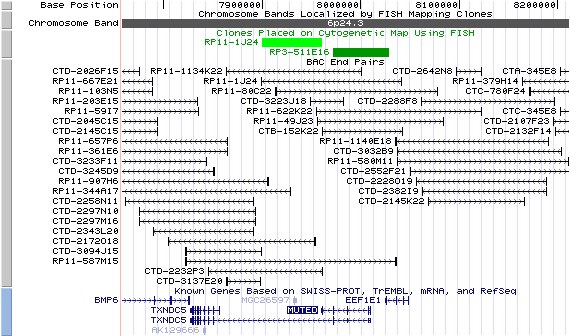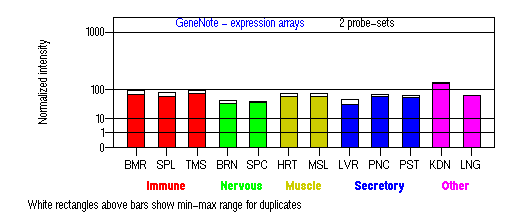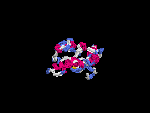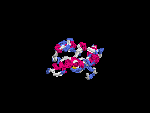GENOMIC
Mapping
6p24.3. View the map and BAC clones of FISH (data from UCSC genome browser).

Structure
(assembly 7/03)
MUTED/NM_201280: 5 exons, 50,431bp, Chr6: 7,959,216-8,009,646.
The figure below shows the structure of the MU gene (data from UCSC genome browser).
Note that the longer transcript variant of TXDNC5/NM_022085 contains exons 1-4 of MUTED.

Regulatory Element
Search the 5'UTR and 1kb upstream regions (human and mouse) by CONREAL with 80% Position Weight Matrices (PWMs) threshold (view results here).
TRANSCRIPT
RefSeq/ORF
MUTED (NM_201280),
2,282bp, view ORF and the alignment to genomic.
Note: Some transcripts of the downstream gene TXNDC5 overlap this gene, but they do not contain an open reading frame for this gene.
Expression Pattern
Tissue specificity: Widely Expressed.

BMR: Bone marrow; SPL: Spleen; TMS: Thymus; BRN: Brain; SPC: Spinal cord; HRT: Heart; MSL: Skeletal muscle; LVR; Liver; PNC: Pancreas; PST: Prostate; KDN: Kidney; LNG: Lung. (data from GeneCards )
PROTEIN
Sequence
Muted protein homolog (NP_958437): 187aa,
ExPaSy NiceProt view of Swiss-Prot:Q8TDH9.
Ortholog
| Species | Mouse | Chimp | Chicken | Rat | FuguFish |
| GeneView | mu/Muted | 17708 | 012782 | Loc306868 | 156809 |
| Protein | NP_620702 (185aa) | 30229 (187aa) | 20823 (196aa) | XP_225255 (187aa) | 177063 (139aa) |
| Identities | 76%/143aa | 76%/143aa | 63%/108aa | 81%/152aa | 46%/68aa |
View multiple sequence alignment (PDF file) by ClustalW and GeneDoc.
Domain
(1) Domains predicted by SMART:
a) coiled coil: 154 - 186.
(2) Transmembrane domains predicted by SOSUI: None.
Motif/Site
(1) Predicted results by ScanProsite:
a) Protein kinase C phosphorylation site : [occurs frequently]
20 - 22: SkK,
97 - 99: TmR,
137 - 139: SeK.
b) cAMP- and cGMP-dependent protein kinase phosphorylation site : [occurs frequently]
22 - 25: KRdS.
c) N-myristoylation site : [occurs frequently]
27 - 32: GTagSA.
d) Casein kinase II phosphorylation site : [occurs frequently]
97 - 100: TmrD.
e) N-glycosylation site : [occurs frequently]
113 - 116: NDSV.
(2) Predicted results of subprograms by PSORT II:
a) N-terminal signal peptide: none
b) KDEL ER retention motif in the C-terminus: none
c) ER Membrane Retention Signals: found KKXX-like motif in C-terminus, KFST
d) VAC possible vacuolar targeting motif: found TLPK at 90
e) Actinin-type actin-binding motif: type 1: none; type 2: none
f) Prenylation motif: none
g) memYQRL transport motif from cell surface to Golgi: none
h) Tyrosines in the tail: too long of a tail
i) Dileucine motif in the tail: None.
3D Model
(1) ModBase No entry found.
(2) 3D models predicted by SPARKS (fold recognition) below. View the models by PDB2MGIF.


2D-PAGE
This protein does not exist in the current release of SWISS-2DPAGE.
Computed theoretical MW=21,609Da, pI=7.14 (NP_958437).
FUNCTION
Ontology
(1) Process: pigmentation, vesicle-mediated transport.
(2) Protein interaction in BLOC-1.
Location
Cytoplasmic.
Interaction
Interacts with pallidin, cno, dysbindin, and Blos2 (Ciciotte, et al; Li, et al (2004); Starcevic, et al). The muted protein is a subunit of the biogenesis of lysosome-related organelles complex 1 (BLOC-1), in which it interacts with the products of seven other HPS genes, sdy, pa, cno, rp, Snapap, Blos1, Blos2 (Ciciotte, et al; Falcon-Perez , et al; Li, et al (2003); Moriyama, et al; Starcevic, et al) (view diagram of BLOC-1 complex here).
Pathway
Involved in the development of lysosome-related organelles, such as melanosomes and platelet-dense granules (view diagram of BLOC-1 pathway here).
MUTATION
Allele or SNP
Zhang, et al performed mutation screening of the human MU gene in those HPS patients with no mutations with known HPS genes by amplification of genomic DNAs and sequencing. No defects were observed.
SNPs deposited in dbSNP.
Distribution
(none)
Effect
(none)
PHENOTYPE
(Animal Models)
Mutation in the Muted gene is the cause of Muted (mu) mutant (Zhang, et al), a mouse model of Hermansky-Pudlak syndrome (OMIM 607289).
REFERENCE
- Ciciotte SL, Gwynn B, Moriyama K, Huizing M, Gahl WA, Bonifacino JS, Peters LL. Cappuccino, a mouse model of Hermansky-Pudlak syndrome, encodes a novel protein that is part of the pallidin-muted complex (BLOC-1). Blood 2003; 101: 4402-7. PMID: 12576321
- Falcon-Perez JM, Starcevic M, Gautam R, Dell'Angelica EC. BLOC-1, a novel complex containing the pallidin and muted proteins involved in the biogenesis of melanosomes and platelet-dense granules. J Biol Chem 2002; 277: 28191-9. PMID: 12019270
- Li W, Rusiniak ME, Chintala S, Gautam R, Novak EK, Swank RT. Murine Hermansky-Pudlak syndrome genes: regulators of lysosome-related organelles. Bioessays 2004; 26: 616-28. PMID: 15170859
- Li W, Zhang Q, Oiso N, Novak EK, Gautam R, O'Brien EP, Tinsley CL, Blake DJ, Spritz RA, Copeland NG, Jenkins NA, Amato D, Roe BA, Starcevic M, Dell'Angelica EC, Elliott RW, Mishra V, Kingsmore SF, Paylor RE, Swank RT. Hermansky-Pudlak syndrome type 7 (HPS-7) results from mutant dysbindin, a member of the biogenesis of lysosome-related organelles complex 1 (BLOC-1). Nat Genet 2003; 35: 84-9. PMID: 12923531
- Moriyama K, Bonifacino JS. Pallidin is a component of a multi-protein complex involved in the biogenesis of lysosome-related organelles. Traffic 2002; 3: 666-77. PMID: 12191018
- Starcevic M, Dell'Angelica EC. Identification of snapin and three novel proteins (BLOS1, BLOS2, and BLOS3/reduced pigmentation) as subunits of biogenesis of lysosome-related organelles complex-1 (BLOC-1). J Biol Chem 2004; 279: 28393-401. PMID: 15102850
- Zhang Q, Li W, Novak EK, Karim A, Mishra VS, Kingsmore SF, Roe BA, Suzuki T, Swank RT. The gene for the muted (mu) mouse, a model for Hermansky-Pudlak syndrome, defines a novel protein which regulates vesicle trafficking. Hum Mol Genet 2002; 11: 697-706. PMID: 11912185
EDIT HISTORY:
Created by Wei Li & Jonathan Bourne 06/28/2004